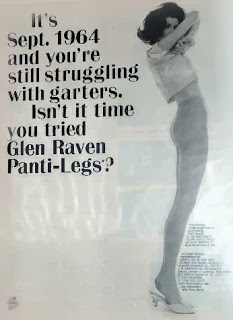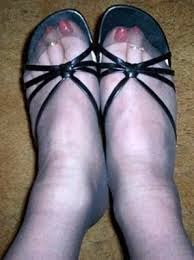Here is the
conclusion of our historical look at hosiery ... did you know?
·
In
1959, Allen Gant Sr patented “Panti-Legs”. This was the birth of pantyhose –
and women would finally be liberated from wearing stockings with suspenders and
clips. At this time, DuPont also
invented Spandex – which would eventually allow hosiery to become stretchier,
clingier, and better fitting.
·
The
1960s fashion for miniskirts required the widespread use of pantyhose as
opposed to stockings, and also as a “modesty” garment; it also put legs up there,
front and centre, and “tights” or novelty pantyhose became a fashion item
rather than a basic staple. Tights in bright colours and even psychedelic patterns
were commonly seen on the streets and in fashion magazines. While solid colours
were most popular, crochet, glitter, motifs, and novelty fabrics were all very
fashionable.
·
While
a more relaxed, bare-legged look was common in the 1970s, hosiery was still big
business. Many still subscribed to the belief that a “lady” wasn’t properly
dressed without wearing hose – and, for more conservative or older women, at
least, flesh toned hose sold well. These hose were hardly attractive, though –
frumpy nude tones which were anything but discreet, worn with (ugh!) open toe
shoes.
·
The
early 1980s saw sheer pantyhose in various colours become popular – candy pinks,
mint greens, white. Power-dressing women stuck to sheer black pantyhose.
·
Donna
Karan, in partnership with Hanes, in 1987 introduced matte jersey black opaque
tights, also offering them in browns and navy. The look took off in a big way –
and stuck, especially as hemlines rose again in the early 1990s.
·
The
mid 1990s again saw hosiery decline as bare legs were acceptable in a more
relaxed dress code – even in winter.
·
Stockings
and suspenders remain a big seller – as novelty, special occasion (such as
wedding), or bedroom wear.
·
Today?
Thanks to the likes of the Duchess of Cambridge, flesh toned pantyhose are
enjoying a renaissance as classy, elegant, and not necessarily for old people.
Today’s sheers truly are sheer, and fit like never before. There are even
toeless hose – so there need never be another open toe shoe plus pantyhose
horror again. Patterned and opaque tights are bestsellers, especially for the
cooler months.
Legwear has come a very long way – and has never been better
for fit, style, and comfort. Is your hosiery wardrobe up to the challenge?











